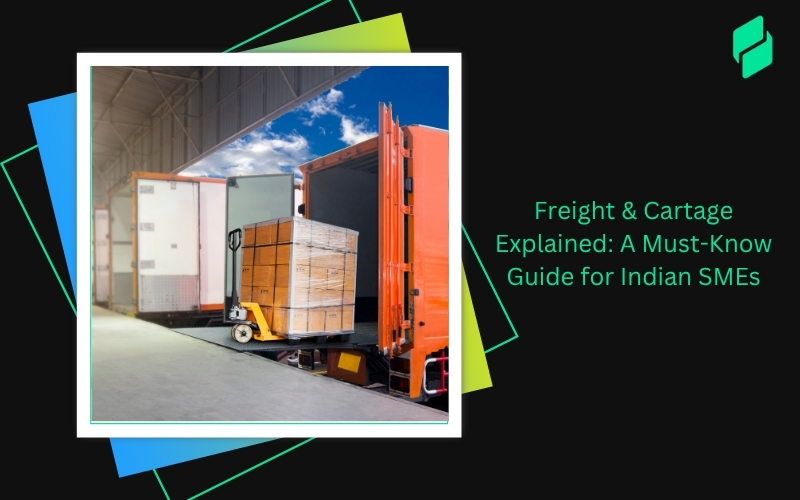Optimize your business: use unlimited savings with Pazago fulfilled now!
Get Started ->India’s container logistics market is undergoing a quiet but significant transformation. In FY 2024-25, the country’s major ports handled roughly 855 million tonnes of cargo, up from 819 million tonnes in the previous year — a year-on-year growth of about 4.3 %. Behind this uptick lies an improved supply of empty containers, more efficient port operations, and a gradual normalisation of the global freight equipment market.
For exporters and importers, understanding container pricing is essential to managing overall logistics costs. Whether you’re purchasing, leasing, or transporting containers across India, small cost differences can impact your margins significantly.
This guide breaks down everything you need to know about shipping container costs in India — from price ranges and influencing factors to route-based expenses and digital solutions that make sourcing easier.
Types of Shipping Containers Available in India
A shipping container is a standardized, durable steel unit used to transport goods seamlessly across multiple modes — sea, rail, and road. In India, the most common container types are 20-foot and 40-foot units, designed to suit different cargo requirements and trade volumes.

1. 20-Foot Containers
The 20-foot (TEU) container is the industry standard for small to mid-sized shipments. It’s compact, cost-efficient, and suitable for businesses shipping moderate cargo volumes.
- Capacity: ~33 cubic meter
- Payload: up to 21,600 kg
- Common uses: dry goods, textiles, machinery, electronics, and general cargo
2. 40-Foot Containers
The 40-foot (FEU) container offers nearly double the space of a 20-foot unit while keeping handling costs proportionally lower. It’s ideal for exporters managing bulk or consolidated shipments.
- Capacity: ~67 cubic meters
- Payload: up to 26,500 kg
- Common uses: high-volume exports such as consumer products, auto parts, and industrial equipment
3. Specialized Variants
In addition to standard dry containers, several specialized types are widely available in India to meet diverse cargo needs:
- High Cube Containers: 1 foot taller than standard containers (9.5 ft high), ideal for bulky or light cargo.
- Refrigerated (Reefer) Containers: Equipped with active cooling systems for perishable goods such as food, flowers, and pharmaceuticals.
- Open-Top Containers: Allow easy loading of oversized cargo using cranes.
- Flat-Rack Containers: Designed for heavy or irregularly shaped goods like vehicles or machinery.
Indian ports — particularly Nhava Sheva (JNPA), Mundra, Chennai, and Kolkata — have abundant availability of these container types, both new and refurbished. Choosing the right variant helps balance cost, cargo protection, and operational efficiency.
Interesting Read: Top Shipping Software Platforms for Small Business Delivery
New vs Used Container Cost Comparison (2025)
When sourcing containers in India, one of the first decisions you’ll face is whether to buy a new (or one-trip) unit or a used (cargo-worthy) container. Each option has trade-offs in cost, lifespan and usability.

Why the difference matters
- New containers come with full structural integrity, minimal wear, and usually valid certification for export use. That tends to command a premium.
- Used containers may have been in service before, often require inspection or repairs, and may have shorter remaining life — but they can offer significant cost savings.
Indicative Price Ranges in India (2025)
Based on aggregated listings and India-specific market data:
- A new 20-ft dry container typically ranges around ₹1.60 lakh to ₹2.00 lakh.
- A used 20-ft dry container (cargo-worthy) generally goes for ₹0.80 lakh to ≈₹1.20 lakh.
- A new 40-ft dry container commonly costs around ₹2.00 lakh to ₹2.50 lakh.
- A used 40-ft dry container typically ranges ₹1.20 lakh to ₹1.80 lakh.
- For 40-ft high cube containers, the new variant often falls around ₹2.30 lakh to ₹2.70 lakh, and used units between ₹1.50 lakh and ₹2.10 lakh.
- Refrigerated (“reefer”) containers command much higher prices — new units in the range of ₹5.00 lakh to ₹10.00 lakh+, while used units might trade for ₹4.00 lakh to ₹7.00 lakh, depending on age and condition.
These ranges tie back to global used container benchmarks. For instance, one international market source reports used 20-ft containers in 2025 were averaging USD 1,500–3,000 (~₹1.32 lakh-2.64 lakh at ₹88/USD) and new ones at USD 2,500–5,000 (~₹2.20 lakh-4.40 lakh).
What to check when comparing new vs used
- Certification: Look for valid CSC plate, ISO compliance and export readiness.
- Condition: Cargo-worthy status (no major structural damage, still wind & water tight) versus “as-is” units.
- Delivery and location: Used units may require repositioning or repair costs not reflected in headline price.
- Usage horizon: If you plan regular reuse, buying new may make more sense. If you’re using short-term or for storage, a used unit often suffices.
Also Read: Understanding Ocean Shipping and Transport Services
Average Shipping Container Prices in India
Container prices across India fluctuate depending on type, size, age, and condition. While base steel rates and port repositioning costs influence supply, the Indian market has remained relatively stable since Q2 2024 thanks to improved container availability.

Here’s an overview of average price ranges for common container types in India:
Notes:
- Prices are indicative and vary by supplier, port, and exchange rate (₹88 ≈ USD 1 as of Oct 2025).
- Buyers should verify if prices include GST, delivery, or inspection charges.
- Lease and rent models typically cost ₹150 – ₹300 per day for 20-ft containers and ₹250 – ₹450 per day for 40-ft units, depending on tenure and port location.
Cost trend (2024 → 2025): Prices for used containers rose slightly (≈ 4 %) due to demand in domestic storage, while new container prices declined marginally (≈ 2 %) following a global oversupply of steel containers.
Choosing the right container dimension is crucial for cost efficiency. With Pazago, you gain access to a wide range of containers and personalized advice to match your specific cargo needs.
To better understand the variation in container prices, it's essential to explore the key factors that drive these costs in India.
Also Read: Calculating Costs for Oversize Load Shipping and Freight Rates
Key Factors That Influence Shipping Container Costs in India
Container prices in India depend on multiple operational and economic factors. Whether you are purchasing or leasing, the following variables drive most cost fluctuations across ports and inland depots.
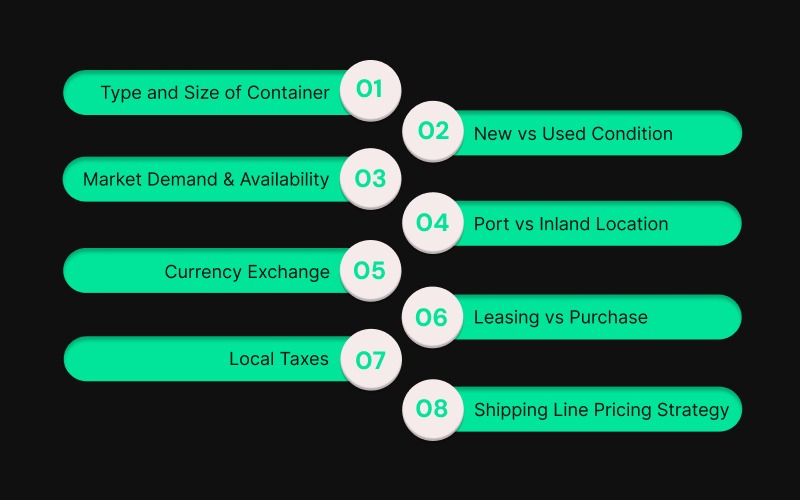
1. Type and Size of Container
The size and design of a container remain the most direct cost drivers.
- 20 ft containers are cheaper to purchase and reposition, suitable for small shipments.
- 40 ft and high-cube containers provide better space utilization but cost 20–35% more upfront.
- Specialized containers such as reefers, open-tops, and flat racks are limited in supply, and their prices often fluctuate sharply with export seasonality or equipment shortages.
In 2025, high-cube units typically cost ₹20,000–₹30,000 more than standard 40 ft dry containers due to their extra height and handling requirements.
2. New vs Used Condition
The container’s age and condition significantly affect price.
- New or one-trip containers command a premium because they comply with the latest ISO and CSC standards and have minimal wear.
- Used cargo-worthy units—5 to 12 years old—offer better value for storage or short-haul trade.
- Containers requiring repairs or recertification (“as-is” condition) can sell 20–30% below cargo-worthy rates but may not qualify for export use.
3. Market Demand and Availability
Container pricing in India closely tracks the global container index and domestic export demand.
- During peak export seasons (September–December, pre-holiday cycle), demand for empty containers rises sharply, pushing up prices.
- When imports exceed exports (e.g., Q2 2025), surplus containers at ports like Mundra and Nhava Sheva temporarily reduce local purchase and leasing rates.
- Freight rate fluctuations also affect leasing decisions: higher ocean freight typically correlates with higher equipment costs.
4. Port vs Inland Location
Where you buy or lease the container influences total cost:
- Major ports such as Mumbai (Nhava Sheva), Chennai, and Mundra have higher availability and competitive prices.
- Inland depots (ICDs) such as Tughlakabad, Nagpur, or Kanpur may add ₹10,000–₹25,000 per container for repositioning and handling.
- Containers sourced near ports are typically 10–15% cheaper than those purchased inland.
5. Currency Exchange and Import Costs
Container prices are often benchmarked in USD.
- With the rupee averaging ₹87.9 per USD in late 2025, any depreciation directly raises container import or leasing costs.
- Even domestic resellers adjust pricing to account for global USD-indexed trade values, which means Indian buyers indirectly absorb exchange-rate risk.
6. Leasing vs Purchase
Both ownership models exist in India’s container market:
- Leasing (short-term): Ideal for temporary projects or one-off exports. Monthly lease rates for 20 ft dry containers average ₹3,000–₹4,500, depending on tenure.
- Purchase: A one-time investment suited for frequent shippers or storage users. Ownership requires periodic maintenance, repainting, and CSC renewals.
While leasing offers flexibility, long-term users often find buying more cost-efficient after 18–24 months of continued use.
7. Local Taxes and Regulatory Charges
Beyond base prices, buyers should consider:
- GST (18%) applicable on domestic container sales.
- Port handling fees (₹3,000–₹8,000 per container) for release or pickup.
- Inspection or repair charges at depots, typically ₹2,000–₹5,000 for used units.
Prices also vary slightly across states due to logistics tax differences and local handling tariffs.
8. Supplier and Shipping Line Pricing Strategy
Pricing can differ across suppliers or container trading companies:
- Larger lessors (like Triton, Textainer, or local yards linked with shipping lines) often provide discounts for multi-unit orders.
- Smaller traders may quote slightly higher prices but include delivery and repair certification.
When comparing quotes, always check for inclusion of CSC certification, delivery location, and inspection status to avoid hidden costs.
Also Read: Shipping Heavy Freight: A Look at Services and Procedures
Calculating Shipping Costs for Various Routes Within India
Shipping container costs in India can vary significantly depending on the route, mode of transportation, and regional regulations. These costs are influenced not only by the distance between origin and destination, but also by infrastructure quality, port handling charges, state-wise tolls, and seasonal demand fluctuations.
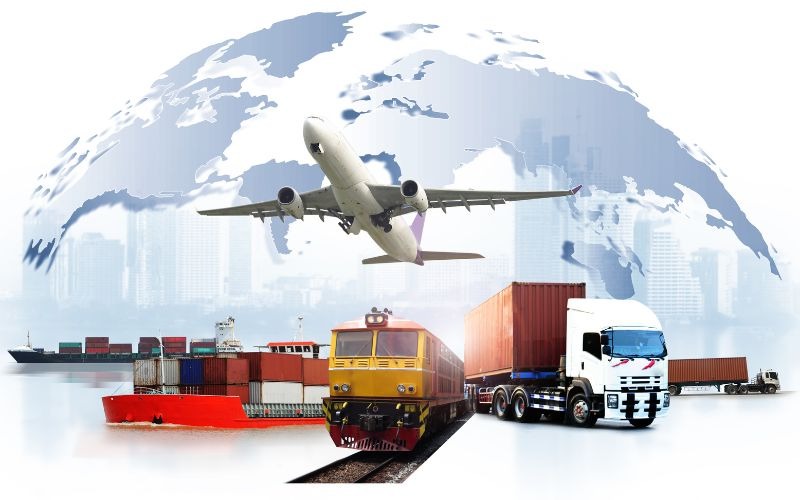
Container transport within India varies significantly by distance, mode of transport, and port connectivity. Whether you’re moving containers between ports or from ports to inland depots, the following estimates will help benchmark typical domestic freight costs.
1. Road Transport
Road remains the most flexible option for door-to-door container movement across India.
It’s ideal for short to mid-range hauls (under 1,000 km) or for final-mile delivery from an ICD or port.
Average road freight rates (2025):
Cost drivers for road freight:
- Fuel and toll expenses (up to 40% of total).
- Empty return legs, especially for one-way shipments.
- State entry permits and seasonal restrictions.
- Container type – reefers cost 25–30% more due to genset fuel.
Road is fastest for flexible delivery schedules, but per km cost averages ₹45–₹65/km depending on lane and payload.
2. Rail Transport
For longer routes (over 800 km), rail provides cost efficiency and predictable scheduling.
Indian Railways and CONCOR-linked operators such as Gateway Rail, DP World, and Adani Logistics handle the majority of containerized rail cargo through inland container depots (ICDs).
Average rail freight (2025):
Rail freight rates are 25–40% cheaper than road beyond 800 km, but involve:
- Port and depot handling charges (₹3,000 – ₹5,000 per container).
- First/last-mile trucking to and from the rail terminal.
- Fixed train schedules, requiring advance booking.
3. Intermodal Transport
Intermodal (rail + road) combines the cost advantage of rail with the flexibility of road.
This approach is increasingly used for cargo bound to inland hubs like Delhi-NCR, Hyderabad, and Ludhiana.
Typical blended cost structure (2025):
- Port → Rail ICD segment: ₹20,000 – ₹30,000 per 40 ft.
- Rail → Final destination by road: ₹10,000 – ₹20,000 per 40 ft.
- Total average: ₹35,000 – ₹45,000 per 40 ft container, depending on distance.
Intermodal movement is 10–15% cheaper than full-road and ensures faster throughput via dedicated freight corridors (DFC), now operational on the Western Corridor (Mundra/Nhava Sheva → Dadri).
4. Port Handling and Ancillary Costs
Besides transportation, expect additional port-related charges:
- Terminal handling charges (THC): ₹3,000 – ₹6,000 per container.
- Customs documentation and scanning fees: ₹800 – ₹1,500.
- Empty repositioning or storage: ₹500 – ₹2,000 per day (beyond free period).
Port efficiency varies — Nhava Sheva and Mundra typically offer lower dwell times, while Kolkata and Tuticorin can have higher handling costs due to older infrastructure.
Summary: Domestic Container Transport Costs in 2025
Key takeaway:
For shipments beyond 800 km, rail or intermodal options yield measurable savings, while road remains optimal for short-haul or urgent deliveries.
Factoring in fuel, handling, and last-mile costs gives a realistic view of total landed cost per container inside India.
Also Read:
How To Reduce Container Shipping Costs?
Top 10 Largest Container Shipping Companies in the World
How to Request and Compare Container Price Quotes in India
Securing the right container pricing isn’t only about finding the cheapest option — it’s about ensuring reliability, certification, and long-term value. With container rates fluctuating based on port congestion, currency, and seasonal demand, it’s crucial to follow a structured approach when requesting quotes from suppliers or freight forwarders.
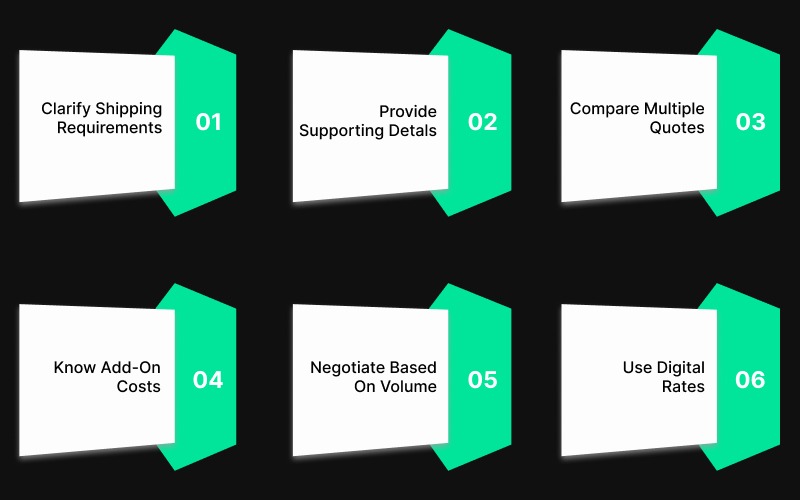
1. Define Your Shipping Requirements Clearly
Before requesting a quote, identify key shipment parameters that determine pricing accuracy:
- Container type and size: 20 ft, 40 ft, high cube, or reefer.
- Condition required: new, cargo-worthy, or one-trip.
- Usage intent: export, storage, or intermodal transport.
- Pickup and delivery points: specify port, ICD, or depot.
- Expected shipping frequency: one-time or recurring.
Providing this information upfront ensures that suppliers quote relevant rates without later adjustments.
2. Include Supporting Details for Better Accuracy
For logistics quotes, freight forwarders or platforms usually request:
- Commodity description and HS code (for classification and insurance).
- Gross weight and volume (CBM) of cargo.
- Preferred mode of transport: sea, rail, or intermodal.
- Expected shipment window (month or quarter).
- Value-added services required: insurance, customs clearance, inspection, or warehousing.
The more precise your input, the closer your quote will reflect the actual landed cost.
3. Compare Multiple Quotes
Never rely on a single quotation. Collect at least three competitive quotes from different providers (container traders, NVOCCs, or digital platforms) and compare on these metrics:
- Base price of container (INR per unit).
- Delivery inclusion: does it cover transport to your location?
- Validity period: most quotes remain valid for 7–10 days.
- Certification: ensure CSC plate validity for export use.
- Repair grade: “Cargo-worthy” or “Wind and Water Tight (WWT)” for storage.
Analyzing these elements reveals the true cost difference beyond headline pricing.
4. Understand Common Add-On Costs
Suppliers often exclude the following from base quotes:
- Port handling and depot pickup charges: ₹3,000–₹8,000.
- Cleaning and repair (for used containers): ₹2,000–₹5,000.
- Delivery or repositioning fee: ₹10,000–₹25,000 depending on distance.
- GST (18%) on domestic transactions.
Clarify all these components before confirming a purchase or lease agreement.
5. Negotiate Based on Volume or Contract Tenure
If your business involves recurring shipments, negotiate longer-term supply or lease contracts.
- Volume orders (10+ containers) often qualify for 5–10% discounts.
- Annual leasing agreements can include free maintenance or inspection.
- Request “buyback” terms if you plan to sell back containers after use.
6. Use Digital Platforms for Live Rates
Digital freight and container management platforms now offer real-time price discovery, letting you:
- Compare container rates from multiple suppliers in one dashboard.
- Filter by condition, location, or certification.
- Access documentation templates and inspection reports instantly.
Using a digital system helps reduce negotiation cycles, avoid hidden fees, and speed up procurement.
Note: Securing the best rates for shipping containers in India requires utilizing the right platforms. Pazago helps maximize savings on 40 feet container shipping in India.
Also Read: Domestic Container and Transportation Services in India
Maximize Savings on Container Shipping in India with Pazago
At Pazago, we simplify every aspect of your supply chain for shipping containers, making logistics clear, efficient, and easy to manage. From shipping to inspections, our solutions keep your products safe and your business moving forward.
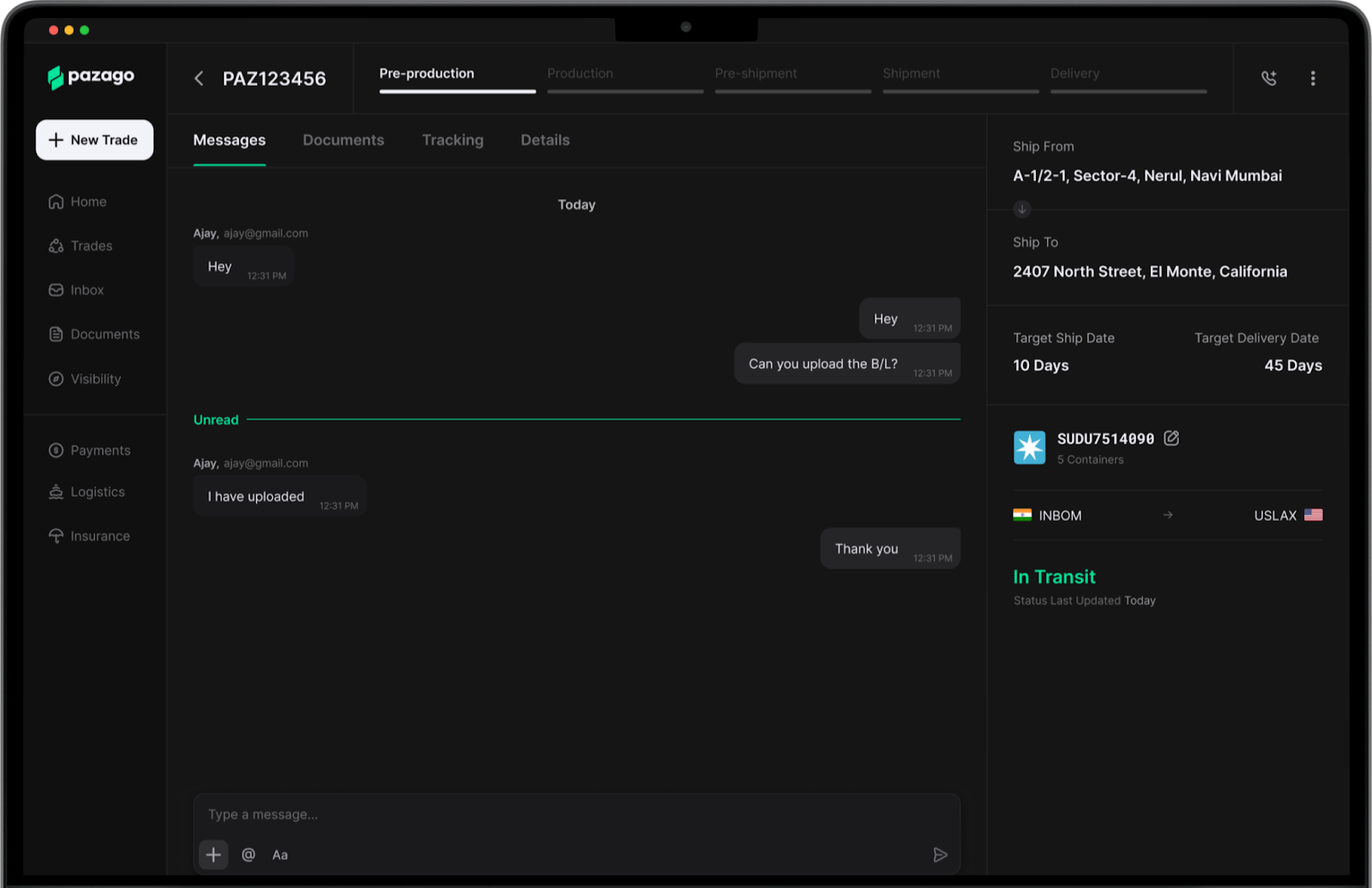
Here’s how Pazago can help you:
- End-to-End Logistics Management: We ensure reliable, fast cross-border shipping with easy coordination from origin to destination. Our system optimizes routes and guarantees timely deliveries, making container shipments efficient and cost-effective.
- Centralized Document Management: Our secure, searchable digital repository integrates regulatory workflows to reduce errors and ensure compliance with international standards.
- 24/7 Real-Time Shipment Tracking: Receive live updates and alerts for temperature fluctuations and other critical shipment conditions. Our real-time tracking system ensures proactive action if issues arise, helping you maintain control over your container shipments at all times.
- Efficient Communication: Our centralized platform facilitates easy communication with partners, enabling quick issue resolution and faster decision-making.
- Integrated Quality Inspections: Manage quality inspections directly from the platform, ensuring compliance with global standards for faster approvals and enhanced product quality.
- Comprehensive Cargo Insurance: With digital policy management, you can easily select the right coverage for your container shipments, protecting against temperature excursions, theft, and damage during transit.
- Financial Simplification: We simplify cross-border payments, and our solutions enable easy financial transactions for your container logistics.
Conclusion
The shipping container cost in India is continually changing, and relying on outdated methods to manage these shipments can lead to higher expenses and inefficiencies. With increasing demand, rising fuel prices, and stricter regulations, it's essential to adopt more innovative approaches to manage your shipping costs effectively.
For small and mid-size exporters, price opacity and fragmented communication often lead to higher container costs and shipment delays.
Pazago solves this by connecting data, suppliers, and decision-making in one secure interface — cutting manual effort and giving visibility into every container transaction.
Ready to reduce your container shipping costs?
Discover how Pazago helps you compare live prices, manage suppliers, and automate documentation.
Book a demo today to make your container logistics faster, smarter, and more cost-efficient.
FAQs: Shipping Container Cost in India (2025)
1. How much does a 20-foot shipping container cost in India in 2025?
A 20-foot dry container in India typically costs ₹1.6–₹2.0 lakh for new units and ₹0.8–₹1.2 lakh for used units, depending on the condition, port, and supplier. Prices may vary slightly at major ports such as Nhava Sheva, Mundra, and Chennai due to local handling charges.
2. What is the price of a 40-foot container in India?
A new 40-foot dry container costs between ₹2.0–₹2.5 lakh, while used containers range from ₹1.2–₹1.8 lakh.
For high-cube containers (9.5 ft tall), expect to pay around ₹2.3–₹2.7 lakh (new) or ₹1.5–₹2.1 lakh (used).
3. What factors affect shipping container costs in India?
Container costs depend on several factors — type and size of the container, new vs. used condition, port location, global steel prices, INR–USD exchange rate, and market demand. Shortages during export surges or seasonal peaks can raise prices temporarily.
4. Is it cheaper to buy or lease a shipping container?
It depends on your usage period.
- Buying is economical for long-term or recurring shipments.
- Leasing (₹150–₹450 per day) suits short-term use or storage needs.
Leasing avoids upfront costs, but ownership offers better long-term value and flexibility.
5. Where can I buy shipping containers in India?
You can purchase containers directly from container depots, port-side suppliers, or verified online platforms such as EximTrader, TradeIndia, and Container xChange. Always ensure the seller provides a valid CSC certificate (for cargo-worthy containers) and includes inspection details.
6. Are used containers reliable for export shipments?
Yes, provided they are cargo-worthy and ISO-certified. Used containers undergo inspection for structural integrity and weather resistance. However, for perishable or high-value exports, most shippers prefer new or one-trip containers to minimize risk.


.png)



